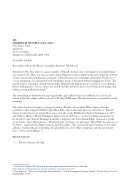Page 166 - TheRussellCatalogue2017
P. 166
206
CHARLES M. RUSSELL (1864–1926) Pony Dance, 1902
watercolor
10 1⁄4 x 14 inches
Inscription: CM Russell/(skull) 1902
$350,000–450,000
Recorded in Charles M. Russell: A Catalogue Raisonné: CR.NE.241
Painted in 1902, Pony Dance is a great example of Russell’s mature style at his height of accomplishment as a watercolorist. ere is a sense of action and complexity as well as depth in the scene depicted. As Rick Stewart states in his monumental assessment of Russell’s watercolor technique and artistry, Pony Dance is “a very transparent, loosely painted work depicting a group of mounted Indians charging into battle. e central warrior, wearing an animal-fur hat and holding his ri e high in the air, rears his horse in dramatic fashion and appears to let out a erce war call. Both rider and horse are covered with painted designs that indicate strong medicine in battle.”1
e central gure’s distinctive fur cap topped with eagle feathers bears a resemblance to a coyote pelt turban in Russell’s studio collection at the C.M. Russell Museum. is distinctive hat is featured in several paintings.
Pony Dance has been thought to portray the famous Blackfoot horse thief, White Quiver. Another possibility is that it depicts SikSika Chief ree Bulls, the brother and successor of Crowfoot.1 Russell’s watercolor may have been inspired by a series of works on the Blackfeet by Frederic Remington in 1887 and 1890 for Harper’s Weekly. Remington made a trip in 1890 trip to see the Sun Dance ceremony, but
he arrived too late. Instead, Remington and his companion, the writer Julian Ralph, witnessed a special “pony dance.” Peter Hassrick states, “Plied with gifts of tobacco, tea and sugar, ree Bulls, the successor to Crowfoot, organized what Ralph termed a ‘grand spectacle.’ e event lasted ninety minutes as the small audience ‘watched the glorious riding, the splendid horses, the brilliant trappings, and the paroxysmal fervor of the excited Indians.’”2
PROVENANCE
• Private collection, Florida
1 See Gustave Sohon’s 1855 drawing in the Washington State Historical Society collection: [http://digitum.washingtonhistory.org/cdm/singleitem/collection/sohon/id/3
2 Peter Hassrick, ‘“They Are a Fine Out t Those Blackfeet’: Frederic Remington in Western Canada,” Alberta History 52, no. 2 (Spring 2004): 27–48.


